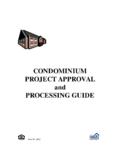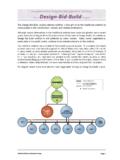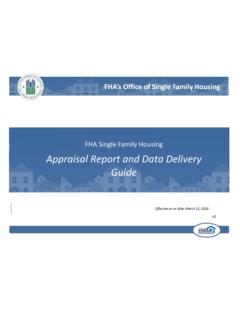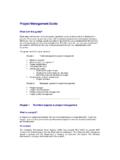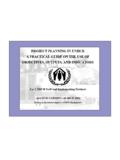Transcription of Project Execution Planning: The Key to Successful ...
1 1 PHARMACEUTICAL ENGINEERING MARCH/APRIL 2014facilities and equipmentProject Execution PlanningProject Execution Planning: The Key to Successful Pharmaceutical Project Deliveryby Robert GarnerThis article presents the importance of a Project Execution Plan (PEP) for a pharmaceutical facilities Project , outlines the fundamental aspects of a PEP, and details what should be included in each very pharmaceutical Project is unique and each Project requires a detailed Project Execution Plan (PEP). The PEP is not a one size fits all document. It must be specifically tailored to meet the size and specific phases of an individual Project .
2 While attributes that are common to all projects include safety, quality, cost, and schedule, each Project combines differences in scope, scale, complexity, resources, and many other factors to achieve its goals and objectives. During the Project develop-ment and delivery process, the concept and Basis of Design (BOD) phases of work are important alignment phases of Project Execution which help to address these attributes as well as many addressed within the PEP. The PEP communi-cates and documents the Project map and the overall stra-tegic approach for the Execution of the entire Project for all stakeholders.
3 It also sets the tone for demonstrating effective leadership, Project organization, progress measurement, and teamwork. A good PEP provides guidance over every applicable element of a Project . Such attention to detail is particularly important for the pharmaceutical industry, which faces regulation from the Food and Drug Admin-istration (FDA) in the form of current Good Manufacturing Practices (cGMP) regulations. A PEP is the product of good Project planning and incorporates several sub-plans, such as a Project procurement (or supply management) plan, Project risk identification and mitigation plan, Project staffing plan, construction Execution plan, cost/budget management plan, Project controls plan, Project quality plan, and overall team alignment.
4 The PEP is typically completed during the early (concept, BOD, or preconstruction) phase of the Project . Preconstruc-tion is critical for the Successful delivery of capital projects. Figure 1. Key Project Execution Plan (PEP) fromPHARMACEUTICAL ENGINEERINGTHE OFFICIAL TECHNICAL MAGAZINE OF ISPEMARCH/APRIL 2014, VOL 34, NO 2 Copyright ISPE 2014 PHARMACEUTICAL ENGINEERING facilities and equipmentProject Execution PlanningFigure 2. Key Project Execution activies based on ISPE s Good Practice Guide: Project Management for the Pharmaceutical Industry Project type early phases of a Project provide owners with a formal approach for developing and executing capital projects.
5 In addition, these early phases help define the Project scope, schedule and cost as early as possible to enable the most efficient use of resources and money, while reducing risks as seen in Figure 1. In order to achieve the necessary level of accuracy, Project Execution planning must be performed in conjunction with the Project s capital planning. Only by tying budget items, line-by-line, to construction tasks can a precise PEP be established. A PEP should be tailored to meet the size, scope, and Execution approach agreed upon for a Project . For instance, a PEP that is used for a $200 million Engineering, Procure-ment and Construction Management (EPCM) plan should be more detailed and extensive than one for a $1 million design-only Project .
6 The key components of the plan should be the same, but the level of detail is different. Every Project should have some form of PEP or alignment document that encompasses the scope and organization of the Project and sets the cadence at Project kickoff. While the PEP provides guidance for the Execution of the Project , it usually starts with a mission statement or overall goal of the Project based upon the owner s requirements, such as scope, technology, business drivers, owner involve-ment, schedule, operations, Project size, regulatory environ-ment, permitting, commissioning, licensing involvement, and expectations for ROI.
7 An example of a simple mission statement might be to deliver the new ABC manufacturing facility in a phased approach that is aligned with the Com-pany XYZ manufacturing strategy and supports the business objectives of its supply chain. Key items to accomplish with this mission include: To meet Phase 1 production dates and requirements in 1Q2014 and Phase 2 in 3Q2015 To provide the new facility and sup-port facilities in a manner that sup-port the production goals stated above To create a safe, productive, collab-orative and highly motivated work culture that supports the achievement of these goalsThe following discussion provides some key elements that should be covered in a PEP - Figure Scope It is important to outline the scope of the Project .
8 As it forms the basis for the effort-hours and overall schedule required to complete the Project from a design, procurement or construction perspective. It also forms the basis for the Project manage-ment constraint triangle: scope, cost, and schedule. Obvi-ously, the larger the Project (defined in scope), the greater the design, construction, and procurement effort it will take to complete. The scope of work is a critical element for cost and schedule management of the Project , and is the founda-tion of the Project . Essentially, the PEP defines the what and where work will be derived.
9 Project Organizational ChartWho is in charge? Who has the authority to allocate costs and make changes? What is the Project reporting structure? How does the team fit together? This should be made clear up front and updated as Strategy and Project delivery ModelIs the Project EPCM, design-bid-build or other? The PEP should reflect the planning of the Project and state the delivery model being utilized. Many specific elements of the PEP are addressed regardless of the contracting strategy, but clearly the PEP will address these requirements from a roles and responsibilities perspective differently depending on the delivery model chosen.
10 The key is to put these thoughts into the PEP and clearly communicate these intentions for the entire team early. The Project delivery decision should be based on a num-ber of factors including budget, schedule, cash flow, Project complexity, risk mitigation, Project team composition and Project goals. Essentially, a Project delivery method is a configuration of roles, relationships, responsibilities, and sequences on a Project . A brief overview of some of the typical Project delivery methods for pharmaceutical projects can be seen in Figure ENGINEERING MARCH/APRIL 2014facilities and equipmentProject Execution PlanningDesign-Bid-Build (DBB)DBB is a common Project delivery method in the phar-maceutical industry.
